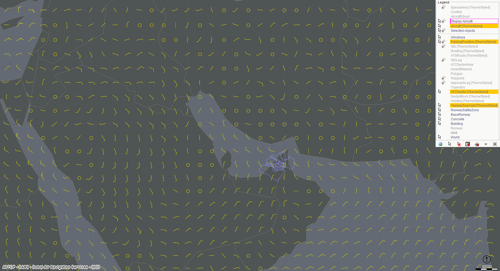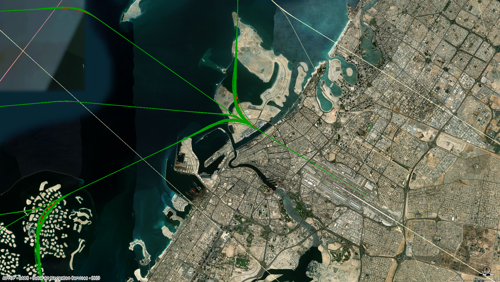
The Middle East, and Dubai in particular, have emerged as prominent hubs for the aviation industry. With its strategic location between Europe, Africa, and Asia, as well as its modern infrastructure and airports, the region has experienced significant growth in air travel and cargo transportation.
Dubai is home to one of the busiest airports in the world, Dubai International Airport (DXB). DXB serves as a major hub for numerous airlines and a popular destination for travelers from across the globe. Dubai has also witnessed the rapid development of another airport, Al Maktoum International Airport (DWC). This airport has been designed to become the world’s largest once completed, with the capacity to handle up to 240 million passengers annually. Another airport situated north of DXB, Sharjah Airport (SHJ), holds great significance within the Dubai Control Traffic Area (CTA). Sharjah Airport plans to expand its passenger capacity to 20 million annually through an expansion project aimed at enhancing the travel experience and delivering exceptional service.
Dubai Air Navigation Services
Successfully providing air navigation services since 1967, Dubai Air Navigation Services (dans) have underpinned the phenomenal growth of the aviation sector in Dubai. dans provides efficient, safe, and reliable Air Traffic Management (ATM) services to its customers in Dubai and the Northern Emirates.
In the coming years, Dubai will experience an air traffic demand increase following the growth agenda of the United Arab Emirates (UAE) airlines. To this end, synchronized action plans for dans and all stakeholders will be required to ensure that the anticipated demand is accommodated while providing an industry-leading customer experience.
By focusing on providing efficient and safe ATM services, dans aims to support the growth of the aviation sector in Dubai
CTA and contribute to the overall success of the industry.
Fast-time simulation use in dans
Fast-time simulations have emerged as a crucial tool for dans projects, offering the ability to conduct in-depth evaluations of new concepts, infrastructures, and procedures within a short period of time in a cost-effective way.
The key advantage of fast-time simulations lies in their capability to provide a realistic representation of airport and airspace operations, facilitating the assessment of proposed modifications without the disrupting of actual operations and saving time and resources.
dans, particularly its Air Traffic Development Division and Airspace Management Department, extensively uses AirTOP, an advanced simulation tool from Transoft Solutions to support daily operations and R&D projects.
Deploying fast-time simulation tools

These are several key projects where dans has successfully deployed fast-time simulation tools to support the decision-making process.
In 2019, the Southern Runway Rehabilitation (SRR) project was undertaken with the aim of strengthening and resurfacing one of the two DXB’s runways (12R-30L) and the adjoining taxiways. To accomplish this task, the aforementioned runway was closed for a period of 45 days, resulting in a significant reduction in the airport’s capacity during that time.
According to the project, part of the DXB movements were planned to be shifted to DWC. The concerns regarding the potential impact of reduced DXB operations and the subsequent increase at DWC were addressed using simulations on the two airports and Dubai CTA airspace.
To replicate the physical characteristics of DXB and DWC airports, two distinct fast-time simulation models encompassing runways, taxiways, and stands were developed. Following the airport layouts, the operational rules used by ATC to manage the traffic were defined in the models as well, including dependency between runways, aircraft separation, taxi flows, tow management, and airline parking stands, among others. Revised traffic samples were incorporated to replicate the expected demand properly. After preparing the models, multiple rounds of validations were conducted in collaboration with Air Traffic Controllers (ATCOs) to ensure that they accurately represented the anticipated operations. To support decision-makers, key performance indicators (KPIs) such as throughput, delays and taxi times were provided as a result of the study. An airspace model of Dubai CTA was also developed in a joint effort with Air Traffic Control’s (ATC) Approach Unit, which provided valuable insights into the sectors’ load during SRR operations.
Following the completion of the SRR project and the availability of operational data, dans conducted further analysis to validate the simulated data against real data. The comparison analysis confirmed that fast-time simulations serve as a reliable tool capable of providing a solid forecast of expected KPIs.
In 2022, taking advantage of reduced aircraft movement due to the ongoing recovery from the pandemic, it was a good opportunity to carry out DXB’s Northern Runway Rehabilitation (NRR) that was initially planned for 2024.
Similar to the approach adopted during the SRR, fast-time simulation was also selected as the evaluation technique for the NRR project. In this case, the goal was not just to analyse the possible impact of the planned traffic for that period on DXB runway performances (throughput and delay), but to analyse the impact of rebalancing that traffic demand as per the airlines’ request.
In a more recent development, a collaborative project named Airfield and Capacity Optimisation Study (ACOS), was undertaken as part of a research study to address the challenges posed by the increasing traffic expected at DXB in the short to medium term. Over a period of two years, dans and its project’s stakeholders worked together to identify the possible issues that could arise from the anticipated increase in traffic demand and explore viable solutions to mitigate these challenges. Trustworthy fast-time simulations were selected to accurately forecast potential bottlenecks.
Various scenarios were meticulously designed and modelled, encompassing two operational configurations and different levels of traffic. A significant amount of effort was dedicated to the modelling of parking allocation strategies with the goal of accurately replicating allocation preferences, airfield utilization, and the planned Pier Service Level. The advanced capability of the tool was leveraged to achieve highly realistic modelling of stand utilization, providing essential KPIs related to parking utilization.
Significant attention was dedicated to effectively managing the arrival and departure flows, as well as the planned entry load into the airspace. This task was made possible by using the diverse options available in the software. In projects involving airports with high traffic demand, the use of techniques and tools that replicate operational procedures and Letters of Agreement becomes indispensable. One such technique is flow control, which efficiently manages the flow of air traffic. By incorporating simulation tools that accurately reproduce flow control processes, the conducted analyses yield reliable outcomes, even during peak traffic periods.
The effectiveness of the model was reaffirmed through rigorous validation cycles. These cycles ensured that it accurately represented airside operations in alignment with existing and future strategies.
Complementing the simulations’ results, thematic workshops were designed to address the identified challenges and as a result, various solutions were generated, grouped and assessed to shortlist the ones to be further validated with the dans FTS Portal and other related techniques.
When considering effective air traffic management, it is crucial to emphasize that it extends beyond airport operations, particularly when anticipating a significant increase in demand. For that reason, the development of an air traffic controller taskload model to represent ATCO workload was a key activity in dans portfolio.

The incorporation of taskload into the airspace models is a positive step forward enabling an assessment of existing
demands as well as potential future requirements, particularly in relation to changes in the airspace.
Furthermore, dans has developed an in-house application called “FTS Portal” that directly utilizes the software output files to generate various types of reports. This innovative solution not only provides seamless and immediate access to KPIs for all the users but, also allows for convenient retrieval of project descriptions and video footage captured during the simulation.
By leveraging the FTS Portal, dans significantly streamlined access to comprehensive data, enabling efficient data analysis and reporting processes. This enhanced capability ultimately strengthens the decision-making process.
Enhancing our models
dans is dedicated to continuously improving the operational performance at all the airports within its area of responsibility (AOR), with a strong commitment to maintaining or even elevating the level of service provided to its stakeholders. With this objective in mind, dans Air Traffic Development Division is constantly enhancing its modelling capabilities by incorporating new emerging features.
Weather conditions play a crucial role in airport and airspace performance, prompting dans to explore the capabilities of the tool in modelling wind and temperature data. By utilizing the importing function, dans has successfully uploaded wind and temperature data provided by the National Centre of Meteorology of the UAE to the fast-time simulation models. The next step involves analysing how these factors impact airport and airspace performance indicators during the summer and winter. dans intends to undertake an extensive study on this subject, which involves defining various scenarios and conducting in-depth analysis to examine the cause-effect relationship.
Environmental consideration
dans acknowledges the importance of environmental sustainability, and its Air Traffic Development Division employs available tools to assess the potential impacts of airspace changes on Environmental KPIs and is currently developing a validation campaign in collaboration with prominent airlines in the UAE. This campaign is designed to validate and further enhance the results generated by simulations through real-time testing and feedback from these airlines. By involving industry leaders, dans aim to review and enhance flight profiles to minimize errors and inaccuracies in the forecasting of environmental KPIs such as fuel consumption, emissions and noise impact. This comprehensive approach ensures the effectiveness and reliability of fast-time simulation models in supporting dans assessments and decision making processes in relation to environmental sustainability.
Unmanned Aircraft Systems and UTM
The UAE government has been proactive in promoting the adoption of emerging technologies in aviation, particularly in the use of unmanned aircraft systems (UAS). Extensive collaboration with all stakeholders is established to ensure the safe and efficient utilization of UAS and its seamless integration into the existing ATM system.
In the Emirate of Dubai, there is a thriving UAS industry with approximately 200 companies engaged in UAS operations. These operations enclose a wide range of sectors, including aerial photography and videography, delivery and logistics, infrastructure inspection, security and surveillance, environmental monitoring, construction and surveying, research and development, and urban air mobility. The diverse applications of UAS highlight their versatility and potential in various industries.
Aligning with the UAE government’s commitment, dans is exploring the possibility of utilizing fast-time simulations to enhance the understanding of the potential interactions between unmanned traffic and other stakeholders within dans AOR and to evaluate the impact of UAS operations on airports and ATM systems. The insights derived from these simulations could support decision-makers with additional information to ensure the safe integration of UAS.
Overall, dans remains dedicated to continuous improvement and innovation in its operations, utilizing advanced modelling capabilities and collaborating with relevant stakeholders to meet the evolving needs of the aviation industry in the UAE and the Emirates of Dubai.

